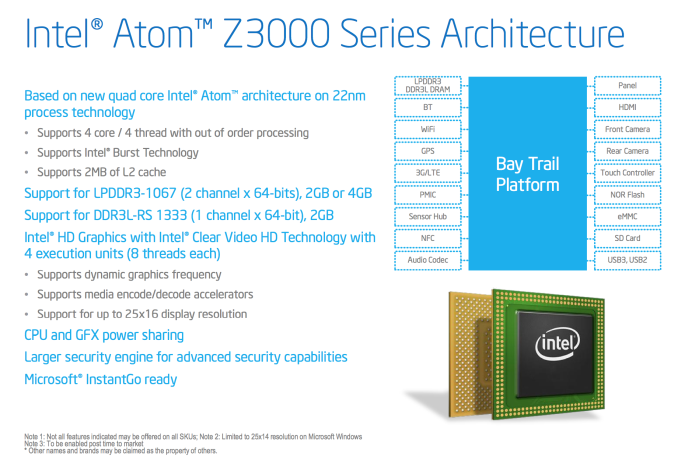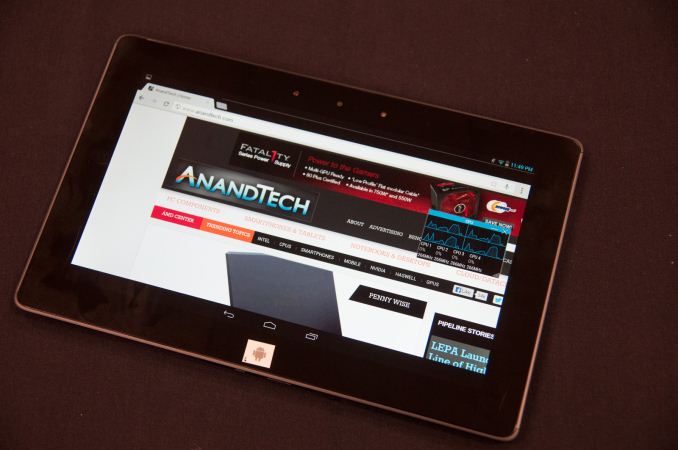The Bay Trail Preview: Intel Atom Z3770 Tested
by Anand Lal Shimpi & Brian Klug on September 11, 2013 12:00 PM ESTFinal Words
At its Silvermont disclosure, Intel promised performance better than any other ARM based core in the market today. Looking at our Android results, Intel appears to have delivered on that claim. Whether we’re talking about Cortex A15 in NVIDIA’s Shield or Qualcomm’s Krait 400, Silvermont is quicker. It seems safe to say that Intel will have the fastest CPU performance out of any Android tablet platform once Bay Trail ships later this year.
The power consumption, at least on the CPU side, also looks very good. From our SoC measurements it looks like Bay Trail’s power consumption under heavy CPU load ranges from 1W - 2.5W, putting it on par with other mobile SoCs that we’ve done power measurements on.
On the GPU side, Intel’s HD Graphics does reasonably well in its first showing in an ultra mobile SoC. Bay Trail appears to live in a weird world between the old Intel that didn’t care about graphics and the new Intel that has effectively become a GPU company. Intel’s HD graphics in Bay Trail appear to be similar in performance to the PowerVR SGX 554MP4 in the iPad 4. It’s a huge step forward compared to Clover Trail, but clearly not a leadership play, which is disappointing.
The big unknowns are things like video decode power efficiency, perf and quality of their ISP and idle power efficiency vs. Qualcomm.
Bay Trail looks like a good starting point for Intel in mobile, and the performance of Silvermont makes me excited for Merrifield in phones next year. What Intel needs to do going forward is simply continue to iterate and execute for the next few generations after Bay Trail and it will have a real chance at success in mobile.
My biggest concern is about the design wins we see based around Bay Trail. Although Intel is finally in a spot where it can be in devices on the market, none of those devices thus far have been any good. Bay Trail is attractive enough to garner more design wins for certain, the question is whether or not the quality of those wins will improve as well. In the tablet market there’s the iPad and the Nexus lines that are really the most interesting, and I don’t expect Bay Trail to be in either. Whether or not the quality of the rest goes up this generation and we find a Bay Trail in one of those devices remains to be seen.












190 Comments
View All Comments
ancientarcher - Friday, September 13, 2013 - link
well, there are two different things here1) whether it costs less vs clovertrail or is it just that the pricing is different: Clovertrail was on the 32nm fab, which is 4-6 years old by now, whereas 22nm trigate is only 2 years old. Apart from the age of the fab, double patterning matters - it means that you have double the number of steps as single patterning (in same stages). Even for relatively old fabs, double patterning will increase costs. Trigate also adds cost, not least in testing. I would bet my last penny that Baytrail is more expensive to manufacture than clovertrail, but Intel is pricing it lower (meaning lower margin) to not repeat past mistakes. Pricing Baytrail at $100+ will mean missing the market altogether, no matter how good the chip is.
&
2) costs versus the core series is irrelevant. The final costs depend primarily on the area of the chip. But Intel hasn't given out any details. WHY??? might I ask. Given the amount of graphics power and cores (4 vs 2 in clovertrail), I would think that the area of the Baytrail might be closer to 100mm^2. So, yea the core i7 processor of 177mm^2 is much larger but sells for $450 retail. Big difference...
By the time Intel is readying to put these in a smartphone, Qualcomm and the others will have products in 20nm (planar) with at least ~30% increase to CPU and GPU (maybe more in GPU on HSA capability) and Intel will fall behind again.
FAIL!!
zeo - Saturday, September 14, 2013 - link
Sorry but you lose the cost bet, for one thing you're forgetting the 22nm FAB reduces the amount of material needed for each chip and they can put more units on each wafer! So mass produced the cost of things like Tri-Gate get absorbed and negated... The increase in cost is also less now than when they first introduced the 22nm FAB. This isn't new technology anymore and the FAB yields are high enough to reduce costs now!Simple fact of the matter is we're already seeing pricing announced for Bay Trail based devices and they're starting well below what Clover Trail devices were introduced at!
The Asus T100 only has a starting price of $349, PCMag even did a benchmark (something to do with matching names and addresses using an algorithm), which took Clover Trail over 30 minutes but the Z3740 in the T100 finished it in just over 15 Minutes... and it includes the Keyboard dock in the pricing!
So the lower pricing and higher performance is a reality!
And no, Intel will already be putting these in Smart Phones by the time Qualcomm and others will have products in 20nm in actual products! Merrifield is getting a early 2014 release and besides, by the time they do push out 20nm into actual products Intel will already be getting ready to push out their 14nm Airmont update, which they already put on a accelerated schedule for rollout!
Really, it's understandable to be pessimistic, Intel took over 5 years to get serious with both mobile and the ATOM but believe it or not they're finally serious about it...
ollienightly - Sunday, September 15, 2013 - link
This is just silly. Intel already put almost twice as much transistors as CT+ in BT-T. The die size should be similar, thus invalidate your whole point of being cheaper. 32nm was back then much older tech than 22nm now. 32nm began shipping back in Q4 2009, CT was some 3-years later. Assuming BT-T ships this year, there's only a 2-year gap since intel's first 22nm offerings. So neither die size nor maturity is on BT-T's side. And the sheer cost in moving to 22nm will be the deciding factor. I wouldn't be surprised if the silicon costs twice as much to make and the total cost is 30% higher.Pricing has NOTHING to do with cost itself. BT-T is priced lower to remain competitive, that's all. Case in point, Haswell 4C-GT2 (177mm2, 4702M@2.2GHz) is more expensive than Haswell 2C-GT3 (181mm2, 4600M@2.9GHz), that is with the same process, TDP, time to market. And higher frequency / bigger die has higher defection rate. So there goes your cost theory.
zeo - Sunday, September 15, 2013 - link
Ship this year?Really? Toshiba, Dell and Asus are shipping Bay Trail based products in just over a month and you're still on whether they'll ship this year!
ollienightly - Sunday, September 15, 2013 - link
Also, keep in mind NVIDIA claims the per transistor cost stopped being competitive beyond 28nm-node. The general trend holds true for Intel. Even more so in CT v BT-T case since 22nm is still young whereas when CT announced, 32nm HKMG was widely used by every FAB in the world.zeo - Sunday, September 15, 2013 - link
Nonsense, first 22nm was started longer than 2 years ago. It only began producing shipping products 2 years ago but they were working on the technology much longer than that and it doesn't take long to perfect, which they have to do before they seriously move on to the next FAB advancement and they're already starting to get ready for that as well!Really, Intel is way ahead on many of these technologies. For example, Intel had been using HKMG at 45nm, long before ARM manufacturers caught up at 32nm, and Tri-Gate is already a well developed technology for Intel. Also, Bay Trail is a much simpler chip than the Core Processors. So it's doesn't require as high precision to make as the much more complex Core processors and thus they are a lot easier to get good yields for them!
And again, my point is the prices of actual devices coming out with Bay Trail is lower than the previous Clover Trail... So regardless of what you think Bay Trail is in fact cheaper than Clover Trail!
Not to mention Intel stated this months ago that Bay Trail will be cheaper than Clover Trail! Actual product pricing shows they kept their word!
monstercameron - Friday, September 13, 2013 - link
wow, do some research dude, oems don't care about power, case-in-point acer w700 and all those other i3/i5 tablets [ivybridge]. The a4-5000 could fit in a tablet just as comfortably.Nagorak - Wednesday, September 11, 2013 - link
In that case, why not just hold out for a Haswell based tablet?lmcd - Wednesday, September 11, 2013 - link
I still wonder what the picture would be like with comparable graphics. Too bad the wait still isn't over. And imagine what happens when Jaguar hits the HPL process Qualcomm got access to.Homeles - Wednesday, September 11, 2013 - link
Jaguar is on GloFo. Snapdragon 800 is on TSMC.